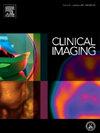透视引导下经皮骶骨成形术使用单弯针:技术说明。
IF 1.5
4区 医学
Q3 RADIOLOGY, NUCLEAR MEDICINE & MEDICAL IMAGING
引用次数: 0
摘要
目的:经皮骶骨成形术是目前治疗疼痛性骶骨功能不全骨折的标准治疗方法,并已被证明可显著缓解疼痛和改善患者的功能。目前,骶骨成形术还没有被广泛接受的标准技术。在这项研究中,我们描述了一种新的透视引导技术,使用单弯针治疗骶骨任何水平的不全骨折。方法:这是一个回顾性的病例系列和技术笔记。回顾性回顾术前记录、手术报告和术后门诊就诊。记录的参数包括术前疼痛评分、合并症、手术细节(包括辐射剂量和持续时间)、并发症和术后结果。结果:2023年1月至2024年6月,我院共对3例患者(2女1男)进行了4例曲针骶骨成形术,其中2例为单例双侧骶骨骨折,1例为左侧骶骨骨折,1例为右侧骶骨骨折。患者年龄从58岁到90岁不等。平均透视时间19.5 min(范围:13.7 ~ 24.9 min),平均辐射剂量774.8 mGy(范围:622.1 ~ 1027 mGy)。无手术并发症。术后所有患者功能改善良好,VAS评分平均下降5.5分,疼痛明显缓解。结论:曲针经皮骶骨成形术是治疗骶骨功能不全骨折的新技术。该技术允许用一根针向不同方向注入水泥。这种方法可能减少手术时间和辐射暴露。本文章由计算机程序翻译,如有差异,请以英文原文为准。
Fluoroscopic guided percutaneous sacroplasty utilizing a single curved needle: technical notes
Purpose
Percutaneous sacroplasty is the current standard of care for the management of painful sacral insufficiency fractures, and has proven to provide significant pain relief and functional improvement for patients. Currently, there is no widely accepted standard technique for sacroplasty. In this study, we describe a new fluoroscopy guided technique using a single curved needle to treat sacral insufficiency fractures at any sacral level.
Methods
This is a retrospective case series and technical notes. A retrospective review of the pre-operative notes, procedure reports, and post-operative clinic visits was performed. Parameters recorded were pre-operative pain score, comorbidities, procedure details including radiation dose and duration, complications, and postoperative outcomes.
Results
From January 2023 to June 2024, four curved needle sacroplasties were performed on three patients (two females, one male) at our institution: two for bilateral sacral fractures in a single patient, one for a left sacral fracture, and one for a right sacral fracture. Patient ages ranged from 58 to 90. The average fluoroscopy time was 19.5 min (range: 13.7–24.9 min), and the average radiation dose was 774.8 mGy (range: 622.1–1027 mGy). No procedural complications were observed. Postoperatively, there was good functional improvement for all patients and VAS scores dropped by an average of 5.5 points, reflecting significant pain relief.
Conclusions
Percutaneous sacroplasty utilizing a curved needle is a novel technique for treating sacral insufficiency fractures. This technique allows the ability to inject cement in various directions with a single needle. This approach potentially reduces procedural time and radiation exposure.
求助全文
通过发布文献求助,成功后即可免费获取论文全文。
去求助
来源期刊

Clinical Imaging
医学-核医学
CiteScore
4.60
自引率
0.00%
发文量
265
审稿时长
35 days
期刊介绍:
The mission of Clinical Imaging is to publish, in a timely manner, the very best radiology research from the United States and around the world with special attention to the impact of medical imaging on patient care. The journal''s publications cover all imaging modalities, radiology issues related to patients, policy and practice improvements, and clinically-oriented imaging physics and informatics. The journal is a valuable resource for practicing radiologists, radiologists-in-training and other clinicians with an interest in imaging. Papers are carefully peer-reviewed and selected by our experienced subject editors who are leading experts spanning the range of imaging sub-specialties, which include:
-Body Imaging-
Breast Imaging-
Cardiothoracic Imaging-
Imaging Physics and Informatics-
Molecular Imaging and Nuclear Medicine-
Musculoskeletal and Emergency Imaging-
Neuroradiology-
Practice, Policy & Education-
Pediatric Imaging-
Vascular and Interventional Radiology
 求助内容:
求助内容: 应助结果提醒方式:
应助结果提醒方式:


